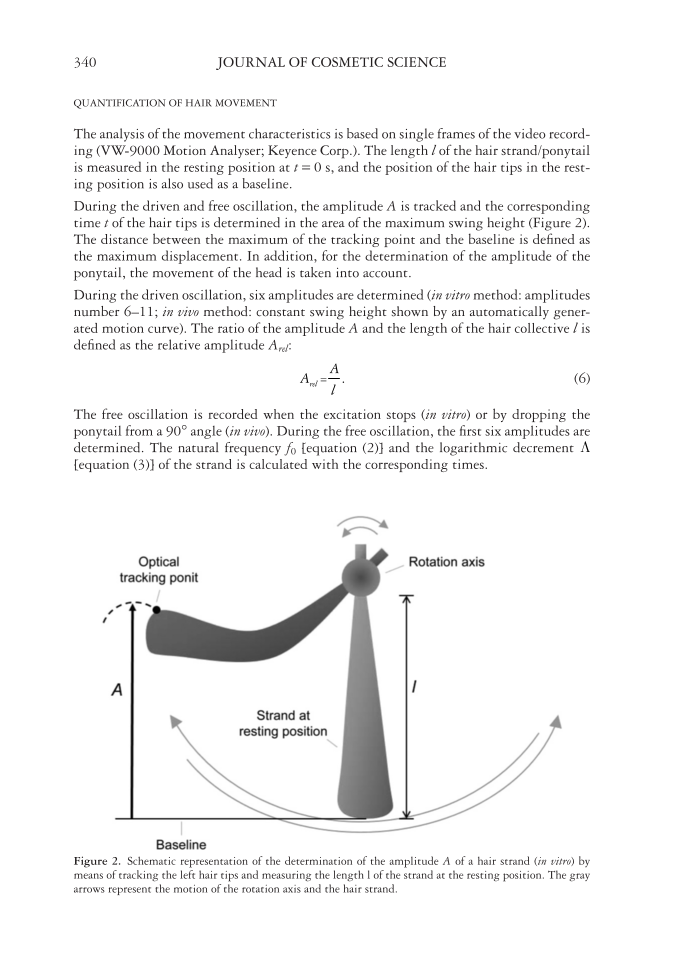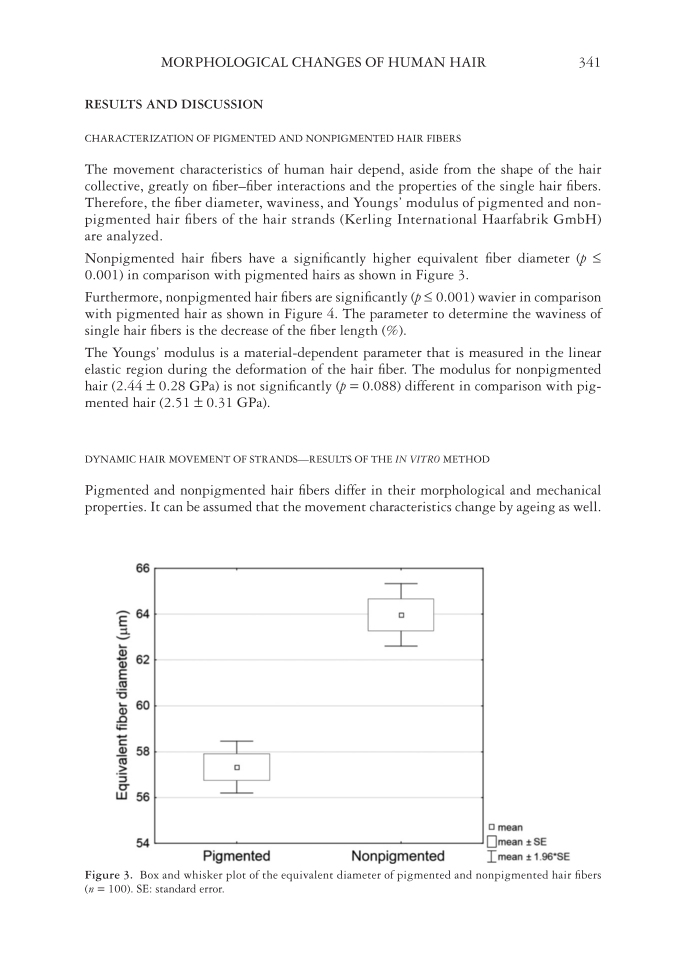JOURNAL OF COSMETIC SCIENCE 340 QUANTIFICATION OF HAIR MOVEMENT The analysis of the movement characteristics is based on single frames of the video record- ing (VW-9000 Motion Analyser Keyence Corp.). The length l of the hair strand/ponytail is measured in the resting position at t = 0 s, and the position of the hair tips in the rest- ing position is also used as a baseline. During the driven and free oscillation, the amplitude A is tracked and the corresponding time t of the hair tips is determined in the area of the maximum swing height (Figure 2). The distance between the maximum of the tracking point and the baseline is defi ned as the maximum displacement. In addition, for the determination of the amplitude of the ponytail, the movement of the head is taken into account. During the driven oscillation, six amplitudes are determined (in vitro method: amplitudes number 6–11 in vivo method: constant swing height shown by an automatically gener- ated motion curve). The ratio of the amplitude A and the length of the hair collective l is defi ned as the relative amplitude Arel: = . A Arel l (6) The free oscillation is recorded when the excitati on stops (in vitro) or by dropping the ponytail from a 90° angle (in vivo). During the free oscillation, the fi rst six amplitudes are determined. The natural frequency f0 [equation (2)] and the logarithmic decrement - [equation (3)] of the strand is calculated with the corresponding times. Figure 2. Schematic representation of the determination of the amplitude A of a hair strand (in vitro) by means of tracking the left hair tips and measuring the length l of the strand at the resting position. The gray arrows represent the motion of the rotation axis and the hair strand.
MORPHOLOGICAL CHANGES OF HUMAN HAIR 341 RESULTS AND DISCUSSION CHARACTERIZATION OF PIGMENTED AND NONPIGMENTED HAIR FIBERS The movement characteristics of human hair depend, aside from the shape of the hair collective, greatly on fi ber–fi ber interactions and the properties of the single hair fi bers. Therefore, the fi ber diameter, waviness, and Youngs’ modulus of pigmented and non- pigmented hair fi bers of the hair strands (Kerling International Haarfabrik GmbH) are analyzed. Nonpigmented hair fi bers have a signifi cantly higher equivalent fi ber diameter (p 0.001) in comparison with pigmented hairs as shown in Figure 3. Furthermore, nonpigmented hair fi bers are signifi cantly (p 0.001) wavier in comparison with pigmented hair as shown in Figure 4. The parameter to determine the waviness of single hair fi bers is the decrease of the fi ber length (%). The Youngs’ modulus is a material-dependent parameter that is measured in the linear elastic region during the deformation of the hair fi ber. The modulus for nonpigmented hair (2.44 ± 0.28 GPa) is not signifi cantly (p = 0.088) different in comparison with pig- mented hair (2.51 ± 0.31 GPa). DYNAMIC HAIR MOVEMENT OF STRANDS—RESULTS OF THE IN VITRO METHOD Pigmented and nonpigmented hair fi bers differ in their morphological and mechanical properties. It can be assumed that the movement characteristics change by ageing as well. Figure 3. Box and whisker plot of the equivalent diameter of pigmented and nonpigmented hair fi bers (n = 100). SE: standard error.
Purchased for the exclusive use of nofirst nolast (unknown) From: SCC Media Library & Resource Center (library.scconline.org)









































































































